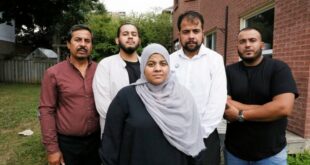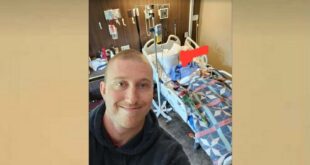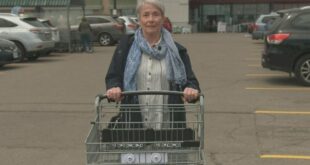In the 1960s, I was often the only Black athlete in races in Canada.
Black Life: Untold Stories illuminates the struggles and triumphs of Black Canadians while celebrating the contributions of both famous and lesser-known individuals. Epic in scope, the eight-part series spans more than 400 years with an eye toward contemporary issues, culture, politics, music, art and sports. The following personal essay comes from Valerie Jerome, who is featured in the episode ‘More than a Game.’ Watch now on CBC Gem.
I have never considered myself an elite athlete, but I guess the word “elite” means different things to different people.
Today, an elite athlete would be someone whose career is fostered by governments and organizations that provide support, advice, clothing and sportswear, plus generously proffered scholarships to educational institutions. When I started running in the 1950s, other than athletic scholarships to the USA — mostly for men — none of these benefits were available to amateur athletes.
An elite career also comes with media attention, and at the end of that elite career, there are records of that elite existence. And it is here that I distinguish myself from my amazing brother, Canadian sprinter Harry Jerome: I was a flash in the pan. Researchers have sought out photos and film of my performances and have come up pretty much empty handed. So to be clear: I was not an elite athlete.
Growing up in very white North Vancouver
We were the only Black family in North Vancouver, where many of the properties had covenants on them that said things like, “When you buy this property, you will not sell to Blacks, Asians or Jews.” We had moved into a house without a covenant, but people on the street still petitioned to block our ability to buy it.
On my first day of elementary school in 1951, white students stood in front of the entrance and threw rocks at us to try and keep us away. After that, I was always anxious on school mornings. I could never choke down breakfast and remained underweight.
I was a timid, none-too-active girl, and I never expected to become an athlete — let alone one who competed at Canadian championships, the Pan Am Games and the Olympics.
Where you placed in the race didn’t have anything to do with your colour
There were few public opportunities for girls to participate in sports back then. Community soccer and softball teams were still decades away, and while there were clubs for gymnastics, skating, golf and swimming, they weren’t options for underpaid porters’ families like mine.
When I joined Sutherland Junior High’s track team in 1957, I realized that I loved running and jumping. In the spring of 1958, my brother, Harry, and I joined a newly formed track club in Vancouver. Besides Harry and I, there were just two other Black athletes at the club.
The first time I won a race, I was really surprised. It was a great feeling, and I hadn’t expected it. But for so much of it, it was just the enjoyment of being accepted as a person.
My colour didn’t matter.
We went to these track meets, and we were measured by measuring tape and a stopwatch; where you placed in the race didn’t have anything to do with your colour. I was rewarded for being myself, and that was very powerful.
Winning was a shock
In July 1959, I experienced air travel for the first time when we travelled to Winnipeg for the Canadian national track and field championships. Harry handily won the men’s 100 and 200 metres. No one was surprised, as he had shown great promise during an earlier training camp.
But it was a shock to everyone — especially me! — when his little sister, just two months after her 15th birthday, won three gold medals and one bronze. My fifth medal of the meet was another gold for our B.C. 4×100-metre relay team.
At the end of the meet, both Harry and I were named to Canada’s Pan American Games track team that would compete in Chicago in August. There, I made the finals in the 60 metres, and placed seventh in the long jump and fourth in the 100 metres (and was extremely pleased to be that close to a medal). Our relay team won bronze.
As we stood on the podium to receive our medals, I was overwhelmed to be standing beside the first place relay team, the all-Black Tennessee State University Tigerbelles. Track and field was pretty much an all-white sport then, especially for women. The Tigerbelles would go on to set the world on fire by winning 23 medals at the 1960 Olympic Games.
Their coach, Ed Temple, offered me a scholarship to join his phenomenal team. I was deeply honoured but told him I had just finished ninth grade.
Even if I had been old enough to accept, I was terrified of living south of the Mason–Dixon line. I could barely survive the continual onslaught of racism in North Vancouver; his all-Black teams travelled to track meets all over the U.S., where they were denied hotel accommodation and use of the washrooms at gas stations.
Training for the 1960 Olympic Games in Rome
Back in Vancouver, I knew there was a possibility that I could reach the Olympic Games in Rome the following year. So that winter, I trained through darkness, rain and snow.
Photos on the fashion pages of a Vancouver newspaper gave me encouragement through our coldest workouts. Only 12 women would be representing Canada at the 1960 Olympics and each would receive a huge wardrobe. The images of blue velvet coats and periwinkle evening gowns with spaghetti straps fuelled some of my most gruelling, mud-sodden interval workouts.
My hard work paid off: I was named to run the 100 metre and the 4×100-metre relay at the 1960 Rome Summer Olympics, and my brother Harry would be there too.
But the heat in Rome was oppressive. I advanced to the quarter finals but not the semis, my times reflecting the less-than-adequate training I was managing to put in, the fact that I was totally out of my league and, no doubt, dehydration. At that time, what we ate or whether we hydrated adequately was never a consideration. There was a water fountain at the track, but bottles of water were still at least one generation away.
Harry suffered a hamstring injury in his semi-final heat. The team officials and the media crucified him, calling him a quitter. I could not have imagined a white athlete being treated as he was. Some Canadian officials had even bet against my brother before the heats began, and they were proud to announce this to the media. The joy of the Olympics was over for me.
Still, I vividly remember the closing ceremonies, when tens of thousands of spectators made torches of their programs to light the darkness of the hour. Ethiopian Abebe Bikila, the first Black African to win an Olympic gold medal, entered the stadium after running barefoot to win the marathon. He — and we — had come a long, long way.
A horrific memory from the Commonwealth Games
Shortly after returning to Vancouver, my running career ended when I tore my left hamstring training on the starting blocks. Or so I thought.
I left home and attended university, and in 1964, got married and began my teaching career. But my husband, Ron Parker, was a fervent track and field participant. He coached and competed, and I was happy to join him in workouts at my beloved Brockton Oval. By 1966, we were both vying for positions on Canada’s team for the British Empire and Commonwealth Games in Jamaica — and I ended up qualifying for the team.
While my performances at the Games were uneven, and my confidence rarely accompanied me to the starting line, I was thrilled to watch Harry win the gold medal in the 100-yard dash and see my teammates succeed.
But one of my most horrific memories is also from the Games. Wrapped in nothing but towels, every female competing was marched across the campus of the University of the West Indies to sit before a panel of doctors and spread our legs. This “sex test” was a response to the concern that some athletes at the 1964 Olympics might have been more male than female.
With not much heart in it, I continued to attend practices and do a bit of coaching. In 1968, I continued with lacklustre performances on the Canadian team’s European tour. For me, the highlight was winning the 100 metre in the dual meet in Stockholm, since it took place in the same stadium that my grandfather had run in during the 1912 Olympic Games.
‘This isn’t just about Black people, and it’s not just about sports’
My running career ended for the second and last time shortly after that. I went on to spend more than 35 years as an international track and field official, working at Olympic, Commonwealth and World Athletics Championship competitions as well as at hundreds of local, provincial and national meets. I felt a strong need to repay what had been done for my brother and me.
In the late 1980s, I remember staring in the window of a television store, looking in awe at the starting lineup of the men’s 100-metre final at a Canadian national track and field championship. Every finalist was Black.
I was stunned by the contrast from the 1960s, when Harry or I would be the only Black competitor crouched in the blocks. We felt like oddities back then, but when I saw all those men on the track, it made me feel like we were truly part of this sport — and, in a larger context, part of this country.
We have a place here.
This isn’t just about Black people, and it’s not just about sports; it’s about all of us and the feeling that we belong. I long for a future when young people can see themselves in all aspects of Canadian life, not just as athletes, but as executives, scientists or whatever they want to be.
Watch “More Than a Game” Wednesday, Nov. 29, at 9 p.m. (9:30 p.m. NT), on CBC-TV and anytime on CBC Gem.
For more stories about the experiences of Black Canadians — from features on anti-Black racism to success stories from within the Black community — check out Being Black in Canada, a CBC project Black Canadians can be proud of. You can read more stories here.

ABOUT THE AUTHOR
Valerie Jerome is a retired school teacher who lives in Vancouver. Issues that have defined much of her life include Green politics, public speaking on issues of race and enthusiastic advocacy in the dance community. Her memoir Races was published September 2023.
*****
Credit belongs to : www.cbc.ca
 Atin Ito First Filipino Community Newspaper in Ontario
Atin Ito First Filipino Community Newspaper in Ontario






